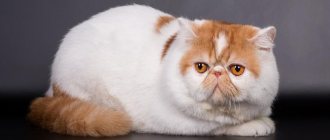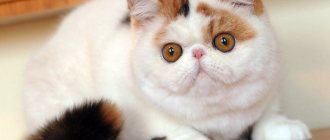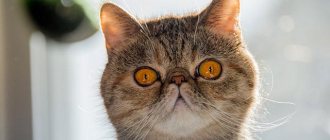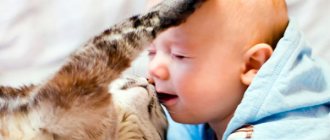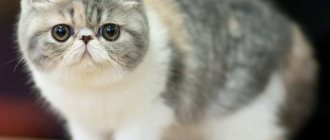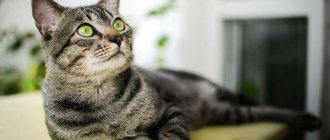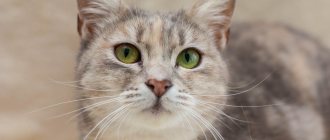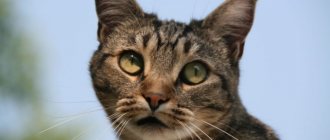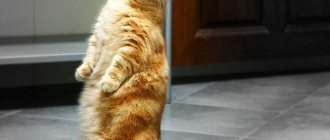Exotic Shorthairs are compact, attractive cats with plush fur, a flattened nose and huge, expressive eyes. Thanks to their charming appearance and friendly disposition, they are the object of dreams for adults and little animal lovers. But in order for communication with an exotic to bring only joy, before buying an exotic, you should study the main characteristics of the breed.
History of the Exotic Shorthair cat breed
Exotic Shorthair cat
The appearance of the Exotic Shorthair breed dates back to the 50s of the last century. Frankly speaking, the first kittens appeared completely by accident. Wanting to get new coat colors and eye colors, American Shorthair breeders crossed their pets with Persian cats. Another goal of these attempts was to make the physique of “American women” more dense. The task was not solved. The offspring, to the surprise and disappointment of the breeders, turned out to be very “Persian” - all the animals were born with characteristic “doll” faces. And in other respects, the kids were more like their parents “from the East.” Only the fur became noticeably shorter and acquired a denser, plush structure. As a result of crossing, it was not possible to improve the American Shorthair cat breed, but completely new kittens with an outlandish appearance were born.
Already in 1966, Jane Martink introduced a new breed, which was given the name “Exotic Shorthair”. The accidentally bred cats took a long time to achieve recognition. Ambitious people were critical of “exotics”, believing that they encroached on the purity of this breed. It got to the point that they refused to mate their elite pets with exotic shorthairs, and they did this consciously and in an organized manner. Fortunately, there were far-sighted owners of the “Persians” who saw the prospects and took part in the selection. Among them, special mention should be made of Doris Walkinstick and Caroline Bussey, whose merits in the formation of a new breed can hardly be overestimated.
Representatives of the Russian Blue breed and Burmese cats were also used in breeding work. The experiments were stopped only when the shorthair gene was firmly established. Since then, matings of exotics have been possible only with Persians.
In 1990, felinologists came to an agreement that the breed standard completely duplicates all the requirements for the Persian cat, with the exception of the length and quality of the coat. Based on these agreements, all changes that are made to the Persian breed standard automatically become relevant for the exotic shorthair cat.
Owner reviews
At a young age, such pets simply amaze with their curiosity and mobility. Over time, growing up, exotics acquire the features of respectable pets, with the manifestation of laziness, which is associated with constant rest, especially lying on their backs. At the same time, the cat will not mind if the owner scratches her belly area.
The advantage of the breed is that the mature age of cats begins at 2 years of life, while the sexuality of the breed is quite weak compared to other cat breeds. After fertilization, a cat can give birth to both short-haired and long-haired kittens. Short-haired individuals do not require special coat care.
These pets sometimes show selectivity in food. At one point, the cat refuses its favorite treat and begins to beg for something tasty. If such a cat regularly visits the street, it prefers to stay close to the entrance or on the porch. She does not get involved in any confrontations with yard cats. Sometimes they sit in an apartment for months, and then suddenly change their living conditions, coming home only to eat and spend the night.
Interesting moment! The exotic shorthair cat is loved by everyone, especially children, who agree not to let such a pet out of their hands. As for the cat herself, she does not like such annoying behavior from children and will try to sneak away at the first opportunity.
The exotic shorthair cat is a unique artificially bred animal. In order for her to become a real favorite for the whole family, she needs to be looked after, as well as shown attention and care. As a rule, love is always answered with love, which is true in relation to our smaller brothers. Despite the fact that they have their own language of communication, they very sensitively feel how their owner and family members treat them.
Exotic appearance
Exotic kitten
The ideal exotic shorthair cat looks like a well-balanced animal with strong, even somewhat heavy bones. The coat gives the outline softness and roundness, the expression of the muzzle conveys complacency and calmness of character.
Head
Round in shape, quite massive. The skull is very wide with a round bone structure. The chin is well developed and round in shape. The jaws are strong and wide, the cheeks are full.
Eyes
The eyes of an exotic cat are located far from each other at the same level. The shape is large and round.
Ears
Small size, round shape. Set wide and low on the head, slightly tilted forward. Not very open at the base.
Nose
Wide, short and upturned. “Stop” is located clearly between the eyes.
Exotic cat face
Body
The body of exotics is medium or closer to large in size. Squat, with well-developed muscles, without signs of obesity. The chest is wide, the shoulders are massive.
Limbs
Exotic standing on his hind legs
Strong, short, massive. The front ones are straight, the rear ones are straight when viewed from behind.
Paws
Exotic paws are large and round. There are 5 toes on the front paws, 4 on the hind paws.
Tail
Proportional to body length, although it can rather be defined as short. No bends. The animal is held at a level below the back.
Wool
The exotic cat's coat is thick and plush, with a rich undercoat. Middle length. It feels very soft to the touch.
Disqualifying features
Visible weakness of the hind limbs, tail defects, number of toes that does not meet the standard. Strabismus, asymmetry of the muzzle or head. Visible deformities of the spine. White toes and non-blue eyes for color points.
The nuances of keeping representatives of the breed
Representatives of the exotic breed do not require special maintenance. The nuances described in the table below require attention.
Table 2. Nuances that need to be taken into account for the correct maintenance of exotics in the apartment.
| What is necessary? | Description |
| Place to sleep | The pet needs somewhere to spend time. A cozy cat house is perfect for this purpose, with a soft bed and a surface for sharpening claws. It will be ideal if the house is located as close to the owner as possible: then the baby will feel comfortable and safe. |
| Rest | Due to their thick undercoat, exotics are always hot, so they like to lie on a cold windowsill in winter or on a tiled floor. There is no need to let them lie in the cold for a long time, as the body of these cats is prone to colds. |
| Toys | For a cat who is often left alone at home, it is best to buy various toys so that he has something to occupy himself in the absence of his owner. Small balls, soft toy animals or candy wrappers tied to a string will do. |
| Walks | There is no need to walk cats of this breed, but veterinarians still advise owners to sometimes go outside with their pets. This affectionate baby will definitely not run away on the street - he will try to find some cozy place closer to the owner to lie down there and bask in the sun. |
On average, exotic cats live from 10 to 14 years. If a pet is loved, cared for and fed properly, it can live up to 16-17 years. It is important to give these cats as much attention and love as possible: due to loneliness, they can become depressed and die much earlier.
Important! If there is an exotic cat in the house, the windows must be covered with a mosquito net or completely closed to prevent the cat from falling from a height. Unlike other cats, who after jumping out of the window can calmly get up on their paws and go play, for exotic cats this can end sadly due to their strong bones.
Exotic photo
Colors of exotic cats
Representatives of the breed can have completely different colors. These can be solid colors or unexpected tabby colors. Below are just a few of them.
Table 4. Colors of exotic cats
| Hue | Description |
| Red tabby | It is distinguished by a pronounced shade of red on the back, which passes to the stomach with less brightness |
| Marble | A color that is rich in various shades. It can be black-gray, reddish-beige or other colors, but always in the form of a marble pattern. |
| Blue | This is the name of the gray-blue color, reminiscent of the Russian Blue breed. |
| Black | Pure black color without any variations. |
| Tortoiseshell | Symbiosis of several colors in different proportions. |
| White | An ideal snow-white shade, in which there are no impurities. |
| Ginger | It has a delicate, slightly reddish tint, more like cream. |
Character of an exotic cat
The character of the exotic shorthair is in amazing harmony with her charming appearance. Friendliness, calmness and complaisance make this animal a wonderful friend and companion. Pets are capable of sincere affection for their owner, but they show their feelings so delicately and subtly that they cannot be called intrusive. They will wait patiently until you finish your business, and only then will they remind you of their presence with a gentle, calm purr. Don't forget to give your friend enough time, because these cats can hardly tolerate loneliness.
With such a “cartoonish” and even somewhat clumsy appearance, exotics are quite active, inquisitive and agile. Moreover, showing natural curiosity, cats of this breed are able to lose their sense of danger. To avoid unpleasant or risky situations, try not to leave your pet alone for a long time. Both kittens and adult animals are playful. Many owners of exotic cats also note that they have well-expressed hunting instincts.
Adaptation of exotics to new conditions due to their livable nature does not present any particular difficulties. Your household, as well as pets already living in the house, will easily find a common language with this cute creature if they are in a positive mood.
Exotic shorthair cats have virtually no manifestations of aggression - in order to bring them out of a state of mental balance and serenity, you need to really want it. The manifestation of hostility, and even then in the form of attempts to avoid close contact, is possible only towards strangers.
Relationships with younger family members almost always go well. Exotics themselves love to play and will gladly take part in children's fun. All you have to do is control the degree of activity and safety of the game on the part of the “human cubs”.
From the point of view of a combination of character traits, temperament and intelligence, the Exotic Shorthair can rightfully be considered a cat ideal for home keeping.
White exotic nestled on the sofa
The nature and behavioral characteristics of exotics
Exotics have higher intellectual abilities than Persians. They are affectionate and curious. They inherited such character traits from American Shorthair cats and Burmese cats. Animals are easy to train and get along well with others.
Positive and negative qualities, animal preferences
The cute face of exotics is not all that these plush cats are loved for. They have a friendly character and are highly trainable. They behave very calmly and reservedly.
They are quite active and love to have fun with their owner. Even with age, the love of games for exotics does not go away, which cannot be said about the Persians, who prefer a calm and measured lifestyle.
Exotics have a calm character and are well trained.
If exotics require attention from the owner, they will never bother him with their meows. They are quite silent, so you won’t hear the annoying “meow” from them.
Table: pros and cons of the breed
| Advantages | Flaws |
|
|
Cohabitation of exotic animals with other animals
Exotics can get along well with other animals, including dogs. If the other pet does not behave aggressively towards the exotic, then they will most likely become excellent friends and spend time together playing their favorite games. It should be taken into account that if there are small rodents (for example, hamsters) in the house with an exotic, then he may mistake them for his prey.
Relationships of the exotic with the owner, with strangers
A distinctive character trait of exotics is their attachment to their owner. As a rule, among all family members they choose one owner who cares about the animal the most. Exotics always strive to be close to a person. They love to sleep in the same bed with him, and sometimes it’s enough for them to just sit next to their owner. Plush pets do not tolerate neglect. If they don’t like a person, they will simply ignore him.
Exotics get along well with people and other animals
Exotics are able to sense the mood of the owner. When they feel unwell, they take on the role of a healer, perched next to the sore spot. Exotics are patient with the pranks of small children and never behave aggressively with them.
Exotic breed cats are more attached and show their love to humans. They do not tolerate loneliness well. Cats, on the contrary, are more independent. They behave more restrained and distant towards the owner. Exotic breed cats are more similar in character to representatives of the Persian breed. The long absence of the owner does not upset them, since cats do not feel strong affection for him. If you want to buy a pet of an exotic breed, but you can’t devote too much time to it, then it’s better to choose a cat of this breed.
Video: plush exotic pets
Education and training
Red bun
The Exotic Shorthair cat is very intelligent, perceptive and trainable. Practice has shown that exotics are able to remember simple commands and prohibiting words. To achieve lasting results, it makes sense to start training from the day you bring the kitten into the house. To make it easier to learn the simplest commands, you can accompany them with short exclamations or simply clap your hands.
The main rule of training is no aggression. The psyche of exotic cats is very sensitive, so you won’t find a better training method than love and patience. By forcing an exotic kitten to do anything through force, threats and intimidation, you will not only permanently lose his trust, but also cause serious harm to the baby's health.
Educational moments—training a kitten to use a litter box and a scratching post—usually pass without much difficulty. It is better to place the toilet in a quiet place where no one will distract your pet from his business. And so that your baby quickly understands the purpose of the scratching post, try spraying it with valerian tincture or a special product purchased at a pet store.
How to care for exotic beauties
Exotics, like all cats, need daily care. It is not as problematic as that of long-haired Persians, but still differs in its nuances. Some procedures must be carried out daily, others every 2 days or once a week.
As a rule, cats love to be brushed.
Bathing and brushing
You don't need to bathe your pet often, otherwise the delicate skin will dry out. Planned water procedures are carried out every 2-3 months, and the baby is also bathed if he gets very dirty. Bathing occurs in several stages:
- Pre-wash using dishwashing liquid. It is used as a preparation for the main wash: the product degreases the coat and allows the shampoo to penetrate well into the thick undercoat. It is better to carry out the procedure twice.
- Wash with a special shampoo for cats containing medicinal herbs or algae extract. During the soaping process, special attention is paid to especially contaminated areas: tail, paws, chin.
- The shampoo must be thoroughly rinsed several times and then rinsed with conditioner.
Some exotic cats simply love to swim.
- Washing is followed by drying with a hairdryer. This is a must, as thick wool will take a very long time to dry naturally. It is also recommended to purchase grooming powder at a pet store and treat the fur with it after drying. This composition absorbs remaining moisture and makes the coat silky.
Important! After routine vaccination, the cat cannot be bathed for 2 weeks, and after antihelminthic therapy - for a day.
Combing is carried out regularly at least 4 times a week. They shed in the same way as Persians, so the fur needs to be freed from dead hairs to prevent tangles from forming. The belly and sides are processed according to the hair growth, all other parts - against it.
It is a known fact that many cats are afraid of contact with water and try to avoid it by all means. In our separate article, you can learn how to wash a cat at home, so that in the future the procedure will become commonplace for your pet.
Eye treatment
The eyes are considered the most expressive and at the same time problematic place in exotic animals. They are large and convex, so dust often gets in there. It is necessary to treat the eyes of exotic animals daily, otherwise inflammation and suppuration may begin. The algorithm is like this:
- Lotion. Purchased at a pharmacy, you need to wash your pet’s eyes with it daily.
- Napkin. After rinsing, blot off excess liquid with a cotton napkin.
- Antibiotic powder. A special powder is applied under the eyes with a cotton swab, which reduces discharge and stops the inflammatory process. It is especially carefully applied to areas where yellow spots from tears have appeared.
A kitten should be taught to treat its eyes from childhood; the procedure should become mandatory and daily.
Ear care
You should clean your exotic cat's ears weekly and every time after bathing. The procedure is carried out using a special lotion from the pharmacy, which is applied to a cotton pad and wiped from the inside of the ear.
In order not to harm the cat during ear treatment, it is better to involve an assistant in the procedure.
Then the washed areas should be dried with a clean cotton pad, and then treated with anti-inflammatory powder. This helps to completely eliminate all impurities and get rid of dead hairs that often get inside the ear.
Cats are very clean animals by nature, but they do not have the ability to care for their ears on their own and need outside help. You can find out how to clean your cat's ears at home in our separate article.
Nail trimming
Cats are taught to trim their claws from childhood, as this is an essential part of grooming. As a rule, claws need to be trimmed once every 14 days.
The claw is trimmed at an angle so as not to damage the thin blood vessels in the claw
This matter should be entrusted to an experienced specialist, since if you are not used to it, you can touch a blood vessel in the claw. It is necessary to cut no more than 2-3 mm from the edge with special veterinary nail clippers.
Cat owners have more than once encountered torn sofas, torn wallpaper and other things used as an alternative to a scratching post. One way to protect yourself from a cat that scratches frequently is with anti-scratch products.
Teeth cleaning
Another necessary procedure, which is carried out at least once a week. Otherwise, there is a risk of developing gum inflammation and the appearance of tartar. For cleaning, use a soft brush; it can be a special cat brush from a pet store or a regular children's toothbrush from a supermarket.
At first, the brush is moistened with water to accustom the cat to the process itself, after which a special tooth powder without flavors or additives is used during brushing.
You should not brush your cat's teeth using human toothpaste: it can seriously harm the baby's digestive system.
Care and maintenance
The exotic shorthair cat is an absolutely unpretentious creature. Professional grooming is not required, which is why representatives of the breed are sometimes called “Persians for the lazy.” But this does not mean that you don’t need to take care of your fur coat. The coat of exotics is very thick, voluminous, soft and well balanced with a soft undercoat. To keep the coat looking healthy and beautiful, you should comb it two to three times a week using a special high-quality metal comb. Like other felines, exotic shorthaired cats take care of their appearance by licking themselves, which is why experts recommend having a means to remove hairballs from the stomach in your veterinary medicine cabinet.
Combing an exotic's fur
Exotics need systematic bathing, at least once a month. The structural features of the animal's face require careful and attentive care - wipe it daily with a damp cloth, paying special attention to the condition of the eyes and tear ducts, as well as the cat's nose. Don't forget to trim your pet's nails twice a month using a safe nail clipper. It is unnecessary to remind you about the mandatory presence of a scratching post.
Provide your pet with a comfortable, safe place where he can rest peacefully. If this is a house, then purchase it in such a way that the animal has enough space to lie down, curled up in a ball or stretched out to its full length. Move your exotic cat closer to you - the pet does not tolerate loneliness well. Some representatives of the breed love to sit or lie for long periods of time on cool surfaces, such as tile floors. To prevent your animal from catching a cold, try to limit the time of these “cooling” procedures.
Om-Nom-nom
If you do not live on the ground floor, make sure there are protective nets on the windows. Exotic shorthairs are large animals, in some ways even obese, and a fall from a height can lead to the most severe consequences.
When deciding on nutrition, remember that adult animals are prone to obesity. To avoid such problems, teach your pet a proper, balanced diet from an early age. Immediately put a taboo on fatty foods and goodies from the common table. The diet should be based on protein products in organic combination with cereals, vegetables and vitamin complexes. The use of premium dry ready-made food from leading manufacturers is completely acceptable.
Important: if you use both dry food and natural products, never combine them. You can alternate, but you can mix – no!
Table: pros and cons of the breed
| pros | Minuses |
| Kind character, love affection and attention, relate well to small children, playful and unforgiving | Susceptible to a wide range of diseases |
| Have a cute appearance | Requires regular eye and ear hygiene |
| Exotics do not require complex grooming | The fur in the area of the flattened muzzle often gets dirty |
| Do not show aggression | The high cost of kittens |
Health and disease of the exotic shorthair cat
Black Exotic
Exotic Shorthair is an artificially bred breed, which in essence is no different from its relatives - the Persians (except for the length and structure of the coat). It is absolutely logical that the genetic diseases in these two breeds are almost identical.
The most common diseases of the respiratory system and eyes occur in exotic animals. The reason is obvious - the unusual structure of the muzzle and the associated deformation of the nasolacrimal duct.
A genetic predisposition to kidney disease and cardiomyopathy is clearly visible. The latter disease very often causes the death of animals of this breed at an early age.
The oral cavity of the exotic can also be considered a risk zone, and a fairly high one at that. Without proper care of your gums and teeth, gingivitis, periodontal disease and other inflammatory diseases may occur. Sometimes cats have abnormally developed lower jaws, which can lead to problems eating.
The best prevention of the occurrence or complex course of these and other diseases is proper care and careful monitoring of your pet’s condition. Timely vaccination, deworming, preventive examinations at a veterinary clinic - all these simple measures will help you avoid unnecessary problems and maintain the health of your exotic shorthair cat for many years.
Exotic health, life expectancy
The lifespan of any cat, including exotics, depends not only on genetic predisposition, but also on the animal’s nutrition and living conditions. On average, representatives of the exotic breed live 15 years, but in the absence of genetic diseases and ideal maintenance they can live longer (up to 20 years).
With proper nutrition and care, exotics can live more than 15 years
Most of the diseases that plush pets are prone to were transmitted to them from the Persians. Thus, exotics may suffer from the following diseases:
- Polycystic kidney disease. Signs of polycystic disease appear already in an adult animal (age 3–10 years). It is impossible to get rid of this problem, but with timely treatment, you can improve your pet’s well-being and slow down the development of the disease. Improvements can be achieved with the help of special therapy and nutritional adjustments. A cat that has this disease begins to lose weight and exhibits disturbances in the functioning of the digestive system (vomiting, loss of appetite). In some cases, cats can become aggressive due to the disease.
- Diseases of the respiratory system. The flattened small nose not only makes these cats look very cute, but can also cause tear duct blockage. This manifests itself in excessive lacrimation in the animal and the development of a runny nose. Exotics often suffer from colds.
- Dental diseases. Exotics often suffer from the appearance of tartar. If you do not pay attention to the problem, it can lead to the development of gingivitis. Gingivitis can manifest itself as acute pain and the development of ulcers on the oral mucosa. It is not difficult to notice a problem in a pet. The cat will refuse food and a foul odor will be heard from the mouth. With gingivitis, the gums are severely inflamed, and the animal experiences excessive salivation.
- Hypertrophic cardiomyopathy. Such heart disease can even lead to sudden death in young kittens. Animals with this disease are very lethargic, refuse food, and quickly get tired after active activities. This condition of the body is associated with a lack of taurine. Males are more susceptible to this disease than cats.
How to choose a kitten
Exotic cat
Life shows that in most cases we buy a cat “for the home, for the family,” so personal sympathy often becomes the main selection criterion. If you are planning to buy an exotic cat to participate in exhibitions or want to seriously engage in breeding, then the selection criteria will be much stricter - it must be a breed or show class kitten, from titled parents with the appropriate documents.
However, in both cases, you must carefully evaluate the external indicators of the baby’s health: feel the tummy, look in the ears, mouth and even under the animal’s tail. It is useful to observe the behavior of your chosen one for some time in order to make at least rough assumptions about his temperament.
You should know that the combination of certain signs in kittens of an exotic breed may indicate the presence of genetic problems. For example, a blue-eyed white creature with a high degree of probability may suffer from hearing loss, or even be completely deaf.
We do not recommend buying a baby who is not yet 3-3.5 months old. By this age, as a rule, breeders have completed the first scheduled vaccination, including the period of mandatory post-vaccination quarantine. Kittens at this age already have certain hygiene skills, and their gastrointestinal tract is ready for the transition from mother's milk to “adult food”.
Before buying an exotic, you should familiarize yourself with the characteristics of the breed, all its pros and cons, in order to make the right choice.
Features of mating and breeding
Exotic breed cats reach puberty at 7–8 months, and female cats at 8–10 months. But in some cases, an animal can reach puberty at a later age (about 2 years).
If the pet is kept for the hobby and further breeding is not planned, then it is best to castrate the animal. The most suitable age for surgery is 7–9 months.
Exotics can only be bred within the breed or with representatives of the Persian breed
It is not worth breeding exotics for the first time at an early age. It is best to allow animals to have their first mating at 12–20 months. If you plan to use an exotic for further breeding, then its owners should consider the following recommendations:
- It is better to purchase a kitten in trusted nurseries from purebred parents, which can be confirmed by the presence of a pedigree.
- The animal must take part in exhibitions.
- When selecting a pair for breeding, it is necessary to carefully study the pedigree of the partner, and also pay attention to the health of the cat.
- After successful mating and birth of kittens, babies should be registered in the club and felinological documents should be completed.
When breeding exotics, breeders are faced with the fact that long-haired and short-haired kittens can be born in the same litter. It is possible to more reliably determine the length of a kitten’s fur only after 3 weeks.
Photos of exotic kittens
Appearance
Persian and Exotic Shorthair breeds have a dense cobby-type
, square format with developed muscles. These are large animals, squat with a massive body. The weight of adult representatives is 4-7 kg. The chest is wide and deep. The body is equally massive and wide at the shoulder and hip girdles, with a well-rounded middle part and a straight back. The limbs are thick, short, powerful. The paws are large, round, dense with tufts of hair between the toes. The tail is short, straight, proportional to the body, with a blunt or slightly rounded tip, slightly below the line of the back and well furred.
A distinctive feature of Persians and exotics is their head and muzzle. The outdated classic version does not have a “flattened” muzzle, their nose is long, the nose is directed downwards and vertically. These representatives are not used for breeding and are sold only as pet-class animals.
The head of the modern Persian and exotic cat is round, massive, with a wide convex skull, wide at the cheekbones, and harmonious. The facial part is round with a rounded bone structure, the forehead is round. Cheekbones are low and wide. Cheeks – round, full. The nose is short, upturned, wide with a sharp transition - “stop”
from forehead to nose.
The length of the nose does not exceed its width. The nose is wide, slightly convex. The nose mirror is well designed. The chin is strong, wide, ideally in a vertical line with the nose. The jaws are strong, with the correct bite, let's say an overshot of 2-3 mm. The line of the upper lip creates the impression of a “smile”
.
The eyes are large, round, expressive, wide open, set wide and straight, slightly surprised - which creates a cute “baby-face”
. The color is uniform and matches the coat color. The ears are small, low set, with rounded tips, well pubescent with good internal tufts. The Persians' whiskers can have an interesting direction - forward and curved upward.
15 cm long
, thick, dense wool with a delicate, airy texture. It is soft, shiny, “alive”, and in good condition. Same length throughout the body. A thick collar covers the neck and shoulders and extends down to the front legs. "Watiness" is not acceptable.
Exotic wool
considered short, it is slightly longer than other short-haired cats. Thick, plush, soft texture, non-fitting, tightly stuffed.
Colors of Persian and Exotic Shorthair breeds
Among Persians and exotics, white, tabby and color-point colors are more common, and solid, silver and golden chinchillas are less common. When assessing color, attention is paid to the color of the coat, pattern, color of the eyes, paw pads and nose.
Solid, solid colors
Black(n)
– black color from tip to roots, without “rust”, without white hairs, without pattern and gray undercoat. The nose and paw pads are black. Eye color – orange or copper, uniform, without inclusions. Kittens may have the so-called “moiré” - a residual pattern; their fur is dark gray with white hairs; complete coloring occurs with age.
Blue (a)
– all shades of blue from light gray to rich steel blue. The color should be clean and uniform, without white hairs or tints. The nose and paw pads are bluish-gray. Eye color – orange or copper.
Chocolate (b)
– all shades of brown, without “rust”, white hairs or patterns. The color is uniform, without gray undercoat. The nose is the color of milk chocolate. Paw pads are the color of cinnamon or chocolate. Eye color – orange or copper.
Lilac (c)
– pale lilac coat with a pinkish tint, without white hairs or patterns. The color is uniform, without gray undercoat. The nose is purple. Paw pads are lilac-pink. Eye color – orange or copper.
Red (d)
– warm red-red color from roots to tips, without marks or light spots. Light shades on the forehead and limbs are acceptable. The nose and paw pads are brick red. Eye color – orange or copper.
Cream (e)
– pastel beige uniform color without an orange tint, without patterns or marks. The undercoat should not be light (white). Eye color – orange or copper.
White (w)
– pure white color without marks or patterns. The nose and paw pads are pink. Kittens may have small blue, red, black, or cream spots on their heads that disappear with age. Eye color – orange or copper, blue, possibly “odd-eyed” – one eye is orange, the other is blue.
Tortoiseshell colors and Particolors
Black tortoiseshell (f)
– a combination of the two primary colors black and red in different proportions. A uniform distribution of colors and the presence of red on the face is desirable. Various shades of red are allowed. The nose and paw pads are black, pink or black with pink spots. Eye color – orange or copper.
Blue-cream tortoiseshell (g)
– a combination of blue and cream colors throughout the body, on the limbs, muzzle, and tail. Lighter shades are preferred. The nose and paw pads are bluish-gray, cream or gray with cream spots. Eye color – orange or copper.
Chocolate tortoiseshell (h)
– a combination of rich, warm chocolate and areas of red. Red can be lightened shades. The nose is the color of milk chocolate, pink or chocolate with pink spots. Paw pads are cinnamon or chocolate colored, pink or chocolate with pink spots. Eye color – orange or copper.
Lilac-cream tortoiseshell (j)
– rich, warm lavender with cream flecks. The nose and paw pads are lilac, pink or lilac with light pink spots. Eye color – orange or copper.
Calico (tortie-and-white)
– a combination of black, red and white colors in various combinations. The nose and paw pads are the same color as the base color. Eye color – orange or copper.
The tortoiseshell color group can be solid or tabby. For a correct determination, it is necessary to evaluate the absence or presence of a pattern on the black (blue, chocolate, lilac) part of the color, since red genetically always has a pattern.
Tabby colors
Tabby is not a color, but characterizes a pattern on the main background, which is manifested due to the presence of the “A” (agouti) gene in the animal.
Marble
(encoding 22) – a clear pattern in the form of wide lines. Large stripes run along the back from the withers to the tail. Several necklaces are attached to the neck. A “butterfly” pattern can be formed on the shoulder blades and curls can be located on the sides. There are 2-3 wide rings on the tail.
brindle
(code 23) – the stripes are narrower, starting from the center line on the back and descending in narrow stripes on the sides. The necklaces on the neck are thinner, the tail is striped.
Spotted
(code 24) – against a lighter background of the main color, clear contrasting spots are evenly located throughout the body. They can be round, oblong, or in the form of rosettes. There are spots on the limbs and preferably on the tail (open rings are acceptable).
The common features of all tabby patterns are the outline of the nose, eyes, the letter “M” on the forehead and the “scarab” on the top of the head. Tabby colors with the presence of the “silver” gene (inhibitor) have a light (almost white) undercoat.
Bicolor colors
Persian and exotic shorthair breeds have three options for combining white and any base color: van, harlequin, bicolor.
- Van
has the maximum amount of white. Completely white body and limbs. Only the tail and the “cap” on the head are colored in the form of one or two separate spots (ideally), always affecting one ear. - Harlequin
. A fifth of the surface of the body is colored, the rest is white. The tail, the “cap” on the head with the obligatory inclusion of one ear, and spots on the back and/or sides must be colored. A white collar is required. - Bicolor
. Half of the entire surface of the body has a basic color and can be located in one continuous area or have an island appearance. For bicolors, the placement of white is mandatory on the muzzle in the form of an inverted “V”, on the chest and lower part of the body, on the hips and legs in the form of “slippers”. A white collar is also desirable.
Tipped colors (tipping, tipping)
This is a group of colors in which the hair has a light root zone and a colored tip. There are two types of tipping: with and without silver (gold).
Silver tipped colors (s is added to the encoding)
- Smoky color
(smoke) - each hair is painted 2/3 from the root with pure silver (almost white) color, including the undercoat. The remaining 1/3 of the hair towards the tip is colored in the main color (black, blue, red, etc.). Eyes must be orange or copper. The nose and paw pads correspond to the color of the main color. Smoky is always a solid color and has no pattern. - Shaded color
(shaded, 11). 1/6 of the hair at the tip is dyed in the main color, the rest is silver. The eyes can be green or bluish-green. The nose and paw pads match the color of the base color. Pewter is a shaded coat with orange eyes, with an eye color code indicated. Shaded cameo - red, cream, tortoiseshell main colors. - Veiled color
(shell, 12). 1/8 of the hair at the tip is dyed, the rest is silver. Chinchillas have green eyes. The nose and paw pads match the color of the base color. Veiled cameo - red, cream, tortoiseshell main colors.
Golden tipped colors (y is added to the encoding)
By analogy with silver colors, golden Persians and exotics can be shaded, when 1/6 of the hair at the tip is dyed, or veiled (1/8 of the hair). The main background is from pale apricot to dark brick with transitions to black. The nose is brick-colored, the paw pads are black or dark brown. The eyes are only green. The main color can be black, blue, chocolate, tortoiseshell, etc.
Shaded and veiled colors are always tabby colors. The pattern, due to the action of the inhibitor gene, looks like a spray on the ends of the coat. There are no classic tabby signs on the face, dark rims on the eyes and nose are required/
Himalayan color (color-point)
Color-points have a lightened body and darker areas - points (areas with low body temperature - muzzle, tail, ears, limbs, scrotum). Like solid colors, they are distinguished: seal-point - black, blue-point - blue, chocolate-point - chocolate, lilac-point - lilac, red(flame)-point - red, cream-point - cream. Tortoiseshell color points - tortie-point - tortoiseshell, blue-cream point - blue-cream, chocolate-tortie point - chocolate tortoiseshell, lilac-cream point - lilac-cream. Patterned tabby color points are not divided into classic ones, since the pattern is quite blurred. They are combined into the links-point color. The eye color of Scottish pointing cats is only blue.
How much does an exotic cat cost?
The price of an exotic kitten depends on several factors. These include:
- compliance with the breed standard;
- “purity of blood” - the more elite the parents, the more expensive the kittens;
- color, its rarity and fashionability;
- routine vaccination carried out.
Prices in professional nurseries are objectively higher than those of private breeders. You can buy exotics even cheaper online or at the poultry market. Although in the latter case, a certain cheapness is more than compensated for by the possible numerous risks. There are even known cases of selling a simply cut Persian kitten instead of an exotic shorthair.
We recommend contacting trusted breeders or nurseries, where the average price of an exotic shorthair kitten, depending on the class, can range from 7,000 to 50,000 rubles.
Basics of proper nutrition for exotics
From infancy, exotics must receive a sufficient amount of vitamins and minerals so that the body develops correctly and the coat is smooth, healthy and silky. Only the owner decides what kind of food will be - natural, home-cooked or commercial from the store.
Important! However, you should consult your veterinarian before choosing a diet. Each individual develops individually, so each may require its own daily menu.
How to properly organize natural nutrition
Owners of exotic cats who decide to feed their pets natural food must remember that it is forbidden to give food from the human table to the animal. No matter how pleadingly the exotic eyes look at the owner during dinner, you need to be adamant.
What should you not feed cats and for what reasons? You can find out in our special article.
You can't overfeed cats. A fat exotic will not lose its external charm, but there will be problems with health.
The diet that a cat requires for the proper development of the body may seem rather meager and unappetizing to some owners, but deviation from it can cause irreparable harm to the pet’s health.
Table 3. Products that should be present in the daily diet of an exotic cat\
| Product | Variations | How to give and what it affects |
| Dietary meat | Veal, beef, rabbit meat | It is given raw, pre-frozen and thawed so that the low temperature kills all parasites. It is necessary to give sirloin parts, as they contain animal protein required for the comprehensive development of all body systems. |
| Poultry is lean | Turkey, chicken | These products are not suitable for daily nutrition, as they do not contain enough amino acids. Chicken or turkey should be given 1-2 times a week. |
| Animal entrails | Lungs, beef kidneys, chicken hearts and ventricles | Wild cats eat small animals along with internal organs, which contain many trace elements. At home, you can fill this gap by using offal, previously scalded with boiling water. |
| Fish, cleaned of bones and scales | Ocean fish – cod, herring, mackerel | Fish is fed once a week; too frequent “fish days” can become an impetus for the development of kidney disease. River fish should not be given at all, as infection with parasites may occur. |
| Dairy products | Low-fat cottage cheese, yogurt, kefir | Fermented milk products must be given to exotics daily. It supplies the cat's body with calcium and helps the normal functioning of the gastrointestinal tract. |
At least 75% of a cat's daily diet should consist of meat, fish and offal. You also need to add a side dish that is mixed with the main dish - it can be porridge, fresh vegetables, herbs, sometimes you can add egg yolk. There is no need to feed your pet tenderloin every day, as such a diet will negatively affect your pet’s health.
Exotic cats are far from omnivores: they will only eat what they like.
Digestion of dairy products is best in kittens; in adult cats, flatulence is possible. Products that were produced 2-3 days before the date of use are best absorbed.
Important! Check the temperature of the food you give your cat every time. It shouldn't be too hot. Permissible temperature - no more than 40 degrees .
How to choose the right industrial feed
In order to feel good and develop normally, your pet must receive all the products necessary for the full functioning of the body:
- vitamins and microelements;
- amino acids;
- saturated fats.
Dry food classes: pros and cons
All these elements are found in vegetables, meat, fish and cottage cheese. However, if the owner does not have time to prepare food specifically for the pet, you can choose a more practical option: buying dry food. It is important to consider that the popular inexpensive canned food sold in supermarkets has a bad effect on your pet’s body. It contains a lot of salt and seasonings, which significantly reduces the lifespan of a cat.
You should pay attention to balanced dry food that is sold in pet stores. When choosing food, you need to pay attention to reviews from breeders and the composition, which should list all the necessary microelements.
Some felines like dry food more than fresh meat or fish.
Javanese
In the late 1970s, Maureen Davis began breeding Siamese-colored Balinese dogs, but in different colors. This is how the Javanese cat breed came about.
Javanese are very active and require a lot of attention, which they achieve by any means. They are distinguished by a strong attachment to their owners. The graceful, fragile appearance of these cats is surprisingly combined with their strength and strong muscles, which are hidden under a thin, silky coat. In everyday life they are hardy and unpretentious, they become very attached to children who know how to handle this independent creature. They mostly get along well with other pets; much in this situation depends on the character of their neighbor.
Intelligence
Exotics are unusually smart animals. They are able to perfectly sense a person’s mood, adapt to the situation and not be too annoying if it is inappropriate. If the owner is in a sad mood, the cat will certainly take on the mission of calming the human soul with his plush presence.
Exotic
These cats are very submissive. When they come to a new home, they politely agree with the rules of the home and never cause trouble. The places allocated for their needs are strictly observed. If their habits do not suit the owner in some way, they are always ready to make concessions to their beloved human being and willingly learn commands. Perfectly capturing the intonation of a voice, these cats become literally controlled remotely. You won't have to get up from your seat to chase away a cat that has wandered into the wrong place. It will be enough to express the command in a confident tone.
